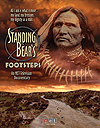 Standing Bear’s Footsteps, by Nebraska Educational Telecommunications (NET) for Native American Public Telecommunications (NAPT) and PBS, 57 minutes, 2012, $29.95
Standing Bear’s Footsteps, by Nebraska Educational Telecommunications (NET) for Native American Public Telecommunications (NAPT) and PBS, 57 minutes, 2012, $29.95
In 1877 the U.S. government forcefully displaced the peaceful agrarian Ponca tribe from its Nebraska homeland on the Niobrara River to Indian Territory (present-day Oklahoma). The exile of the Poncas was the U.S. government’s solution to its own mistake in 1868 of including Ponca land in territory assigned to the Sioux, who then conducted raids against this “tribe of farmers.” Chief Standing Bear was one of the Ponca chiefs who protested his tribe’s removal to the inhospitable southern reservation. After his son Bear Shield fell ill and made a deathbed request of his father that he be buried on the Niobrara, Standing Bear headed out on the grueling 600-mile journey north. En route he was arrested for leaving the reservation and imprisoned at Fort Omaha. He was on the verge of being returned to the “death country” when he decided to fight back—with words and lawyers instead of weapons and warriors.
Claiming he had as much right as any white man to move freely about this country, he took his case to court in May 1879. Thanks to newspapers from The Omaha Daily Herald to The New York Times, Standing Bear drew nationwide support and became an early symbol in the fight for American Indian rights. In his final statement to the court, Standing Bear stood up, raised his hand before Judge Elmer Dundy and said directly to him: “My hand is not the same color as yours. If I pierce it, I shall feel pain; if you pierce your hand, you too will feel pain. The blood that flows will be the same color. I am a man. The same God made us both.” General George Crook, who had detained Standing Bear at Fort Omaha, immediately approached the chief and shook his hand. Judge Dundy ruled, “An Indian is a person within the meaning of the law,” and that Standing Bear “must be discharged from custody.” The decision did not mean an end to trouble for the Poncas. In fact, soldiers shot Standing Bear’s brother Big Snake for defying authorities, prompted in part by the court victory. In 1881 Congress compensated the Poncas for their losses and allowed some of them to acquire homesteads back in Nebraska. Nevertheless, it was not until 1924 that American Indians were finally granted citizenship.
The compelling story of Standing Bear and the Poncas is not as widely known as it should be, but this meticulously produced high-definition documentary should help change that. Judi gaiashkibos, Ponca tribe member and executive director of the Nebraska Commission on Indian Affairs, served as consultant. Produced, written and directed by Christine Lesiak and narrated by Lakota author Joseph Marshall III, the program features rare historic photos, sweeping panoramic shots of the Ponca homeland, and interviews with Ponca descendants and historians.
—Louis Lalire




